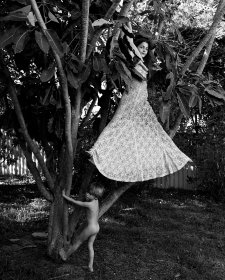Chris: Here we are with our 49 finalists for the 2016 National Photographic Portrait Prize. I'm with my fellow judges, Penny Grist, who's the curator here at the gallery, Narelle Autio, who's our guest judge and a photographer from Adelaide and me, Chris Chapman, senior curator. This morning we've been deciding on our winning photograph and the photograph that we believe is deserving of the Highly Commended Award. We selected these works late last year and we when looking at them as digital files on a very large flat screen. That process is an interesting one to reflect upon in relation to these final framed and printed works that we've got here around us today. Do you want to say something about that Penny?
Penny: Yeah, it's really interesting to see which ones really bring something extra in the final print, particularly the Highly Commended with its traditional printing process was a real standout in that regard.
Narelle: I think, this is the first time I've seen all of the images in their framed format, I guess, and so there was an element of, like I didn't know what to expect really but it's been, I think everyone has brought something really great to this exhibition and really stood up and it's really been interesting to see what the photographer also added to that with their framing and their choice of size and scale. That's been an interesting part of it as well.
Penny: It's always really interesting with the National Photographic Portrait Prize, how each year has a particular atmosphere, so when we select the finalists on the screen from the sort of 2,000 odd entries, we don't select with a particular theme or a particular aesthetic in mind but then when we sort of go back and particularly when I had to go back and write the catalogue essay two weeks later, it's really interesting to see the patterns that have emerged. I think it's probably a combination of what's been submitted that year and maybe the atmosphere of Australia in that year and a combination of our combined reactions to particular imagery and themes.
Chris: How does this year's group feel to you Penny?
Penny: Yeah, it feels really, I felt, it felt really affectionate. There's a great sense of that, sort of the magic of the every day, which is how I've interpreted it in the label. Really that idea of how just ordinary moments in life can have a certain enchantment to them. That can be really captivating and that is something photography is able to capture.
Chris: This year's Highly Commended Award we've given to the photograph portrait of Asha by Sean Davey. It was produced using darkroom processes, it's a gelatin silver print. It's quite intimate, it's quite delicate and for us, it also spoke to a history of modernist photography. It depicts a figure in the landscape, the profile of her body and face starts to become a landscape in itself in a very gentle way. There's also an interesting sense of the interiority of that person's mind. What is she thinking as she's laying there, she's gazing up to the heavens really, is the way that I think about it.
Penny: The winner that we chose this year for the prize was Life Dancers by Elizabeth Looker. It's a really, really haunting in some ways, captivating in some ways, playful photograph of two children playing in a backyard. It's one that really stuck in my mind from the original judging and I think Narelle.
Narelle: I do too.
Penny: It's really what I particularly find, I just find it intriguing. I can't, I find it very comfortable to look at and at the same time quite mysterious, so there's, while it has the story of being her children playing in the garden, it also invites a whole lot of other narratives of your own, that you can build into the work.
Narelle: It is one of the ones that I remembered from our months ago of judging and I was really pleasantly, and I was again, it's lovely to see it in the flesh and I think it has a lot of stuff going on in there. It is a portrait of life. It is one of those moments that has been captured. It's a portrait of kids, it's a portrait of playfulness but there's also something else. It's almost like there's a bell flower hanging from the tree. There's some beautiful composition and dynamics and shapes and stuff going on there, so it brings a lot to the actual photograph and I think that's why I was really attracted to it, it's not just one dimensional. There is all sorts of things you can interpret out of it.














